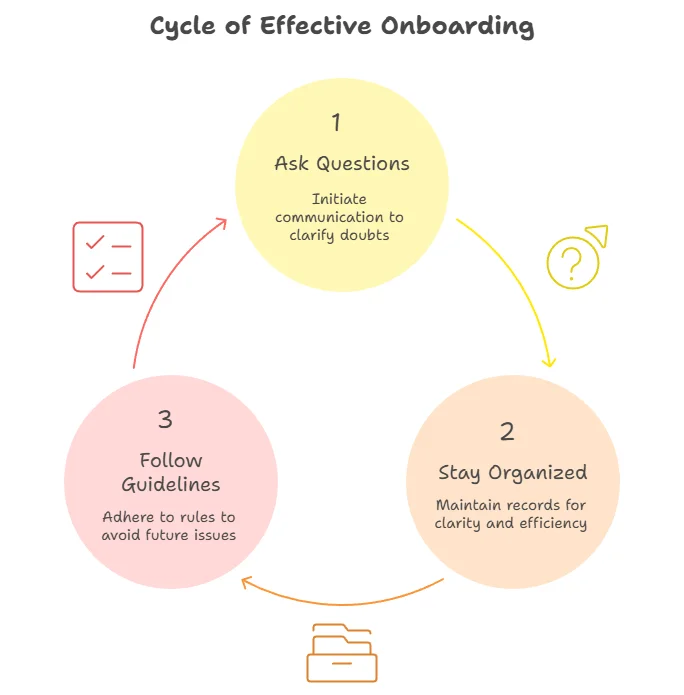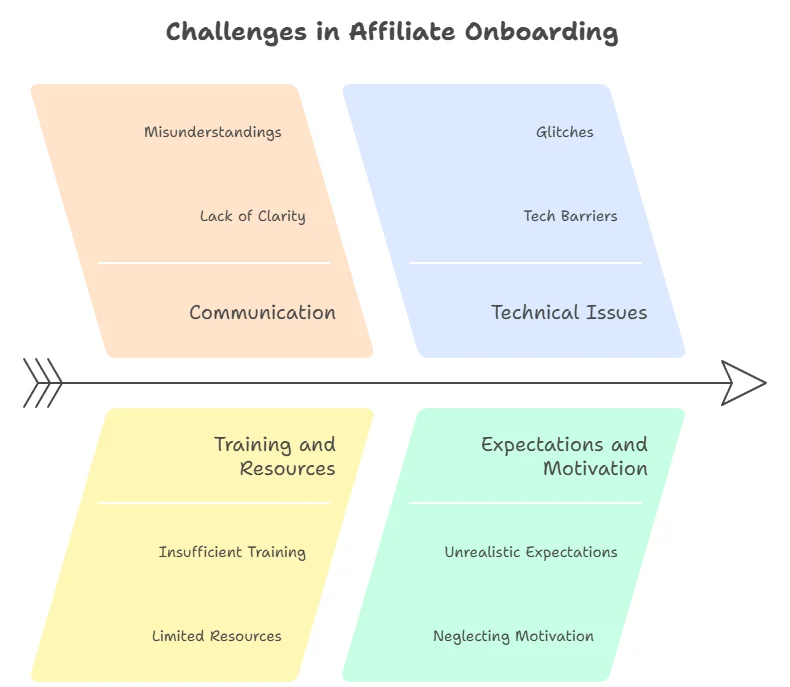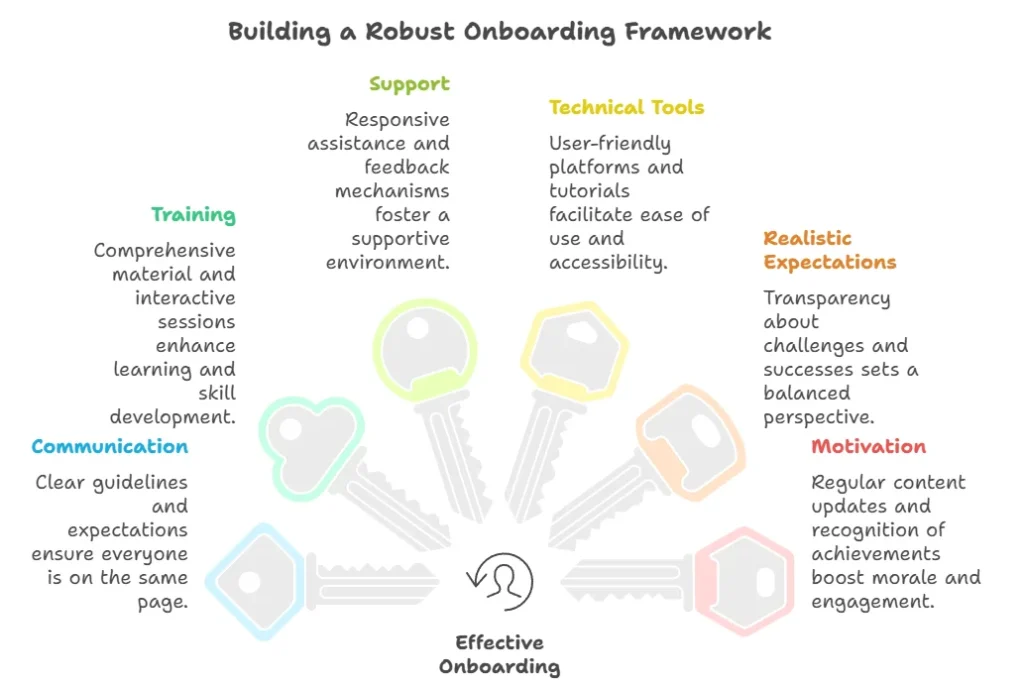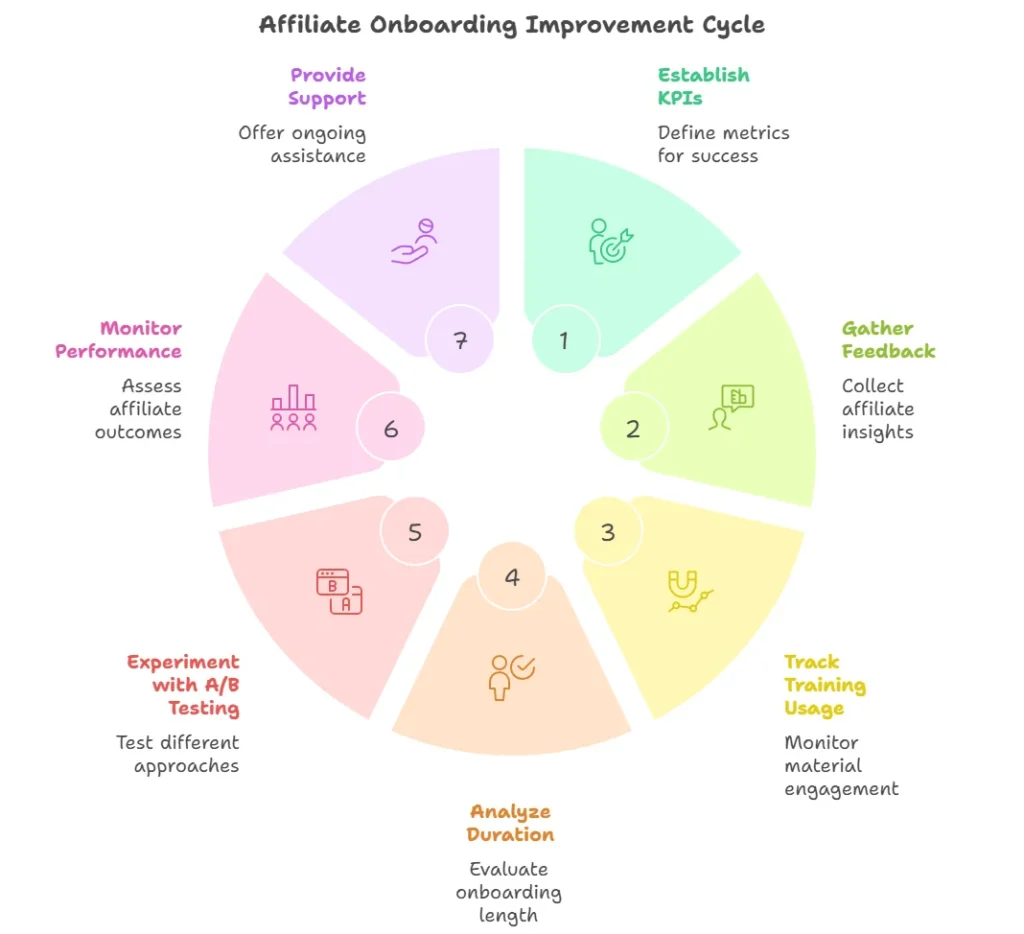 ATTENTION: Want to Learn Affiliate Marketing from Successful Affiliates?
Join this FREE community where successful marketers share their secrets!
Learn directly from highly successful affiliate marketers
Access free, actionable training content regularly
Connect with an active community of over 5,000 members
Network with multiple six-figure earning affiliates
Get your questions answered by real experts
JOIN FREE NOW!
ATTENTION: Want to Learn Affiliate Marketing from Successful Affiliates?
Join this FREE community where successful marketers share their secrets!
Learn directly from highly successful affiliate marketers
Access free, actionable training content regularly
Connect with an active community of over 5,000 members
Network with multiple six-figure earning affiliates
Get your questions answered by real experts
JOIN FREE NOW!
When you step into the world of affiliate marketing, the first hurdle you encounter is the Affiliate Onboarding Process. This crucial phase sets the tone for your relationship with your affiliate program. Let’s explore key steps that will help you navigate this process smoothly and set you up for success.
Understanding the Importance of Affiliate Onboarding
The Affiliate Onboarding Process is not just a formality; it’s a vital component that influences how effective your partnership can be. A well-structured onboarding process helps you:
- Understand the program’s objectives
- Access essential resources and tools
- Establish clear communication channels
- Align your marketing strategies with program goals
Steps Involved in the Affiliate Onboarding Process
To make the Affiliate Onboarding Process efficient, consider the following steps:
-
Registration
Your journey begins with completing a registration form. This form typically requires your contact information, payment details, and information about your marketing methods. Providing accurate data is vital as it ensures your participation in the affiliate program is seamless.
-
Access to Affiliate Portal
Once registered, you will receive access to an affiliate portal. This portal is your go-to place for tracking your performance, obtaining marketing materials, and communicating with program managers. Familiarizing yourself with its layout and functions can significantly improve your onboarding experience.
-
Training Sessions
Many programs provide training to help you understand how to best promote their products. Attend these sessions or watch webinars to gain crucial insights into the brand. Understanding the product’s unique value proposition can help you better market it to your audience.
-
Review of Marketing Materials
Programs often offer a variety of marketing materials such as banners, email templates, and social media posts. Review these resources carefully. Adjust them to fit your brand’s voice while adhering to any guidelines set by the affiliate program.
-
Setting Up Payment Methods
Ensure you set up your payment preferences correctly within the affiliate portal. Review the payment structure to understand how commissions are calculated and when payouts occur.
-
Building Your First Promotion Plan
This step involves brainstorming ways to promote the product. Identify your target audience and choose the platforms where they are most active, such as social media, blogs, or forums. Your promotion plan should include:
- The platforms you’ll use
- The types of content you’ll create
- A schedule for your campaigns
-
Establishing Communication
Direct communication with your affiliate manager is invaluable. Don’t hesitate to reach out for questions or clarification. Building a rapport can aid in obtaining useful insights and resources that may not be readily available.
Best Practices for a Smooth Onboarding Process
While you embark on your affiliate onboarding journey, keep these best practices in mind:
| Tip | Description |
|---|---|
| Be Proactive | Ask questions early and often. This sets the foundation for a successful partnership. |
| Be Organized | Keep a record of important documents and communications to avoid confusion. |
| Follow Guidelines | Adhere to the program’s promotional guidelines to prevent issues down the road. |

Mastering the Affiliate Onboarding Process can significantly impact your marketing success. Paying attention to key steps and best practices will help you to forge a strong relationship with your affiliate program and drive sales effectively.
For more tips and resources on optimizing your affiliate marketing efforts, visit Affiliate Funnel or Affiliate Institute.
Essential Tools for a Streamlined Affiliate Onboarding Experience
In the competitive world of affiliate marketing, a well-structured onboarding process is crucial for both the affiliates and the brands they promote. To streamline this experience, various essential tools can enhance efficiency and effectiveness. Here’s a detailed overview of these tools that can boost the onboarding journey for affiliates.
Affiliate Management Software
Affiliate management software stands as the backbone of an effective Affiliate Onboarding Process. These platforms help manage affiliate relationships, track performance, and analyze data. Some popular options include:
- Refersion – Great for tracking sales and commissions.
- Partnerize – Offers comprehensive tools for partner management.
- CJ Affiliate – A well-established platform with a large network of affiliates.
Using these tools not only centralizes all information but also simplifies communication channels, making the onboarding experience seamless.
Communication Tools
Effective communication is essential for onboarding affiliates. The right tools can ensure that both parties stay informed and aligned. Consider implementing:
- Slack – Facilitate real-time conversations and file sharing.
- Zoom – Host video meetings to discuss strategies and expectations.
- Microsoft Teams – Integrates with Office 365 for a smooth workflow.
Utilizing communication tools helps in maintaining a collaborative environment and aids in addressing questions or doubts quickly.
Educational Resources and Training
Providing resources for affiliates to learn about your brand, products, and marketing strategies is vital. This can include:
- Webinars – Live sessions that give a comprehensive overview of the product.
- Tutorial Videos – Step-by-step guides showcasing best practices for promoting products.
- Written Guides – Valuable documents that cover affiliate policies, commission structures, and marketing strategies.
Offering these resources not only equips affiliates with the knowledge they need but also encourages them to be proactive in their marketing efforts.
Tracking and Analytics Tools
Understanding the performance of affiliates is a key element of the Affiliate Onboarding Process. By utilizing tracking and analytics tools, brands can measure the success of their affiliates effectively. Important tools might include:
- Google Analytics – Helps track website traffic and conversions generated by affiliates.
- WooRank – Provides SEO metrics and insights to improve marketing strategies.
- Mixpanel – A powerful tool for tracking user interactions and engagement.
Using these tools allows brands to provide constructive feedback and refine their programs, which ultimately boosts affiliate success.
Automation Tools
Automation can drastically reduce the time spent on repetitive tasks during the Affiliate Onboarding Process. Tools that help automate tasks include:
- Zapier – Connects different apps to automate workflows.
- Hootsuite – Schedule and manage social media posts easily.
- GetResponse – Automates email campaigns to nurture affiliates.
By employing automation, the onboarding process becomes faster and more efficient, enabling affiliates to focus on driving sales.
To sum up, the right tools play a pivotal role in enhancing the Affiliate Onboarding Process. Investing in robust affiliate management software, effective communication platforms, comprehensive training resources, reliable tracking tools, and automation solutions can lead to a successful partnership between brands and affiliates. These essential tools not only optimize the onboarding experience but also pave the way for long-lasting success in affiliate marketing.
Common Pitfalls in Affiliate Onboarding and How to Avoid Them

Launching an affiliate program can be quite an exciting venture, but novice marketers often stumble during the Affiliate Onboarding Process. Understanding these common pitfalls and learning how to avoid them will set you up for success and foster strong, productive relationships with your affiliates.
Lack of Clear Communication
One major issue is the lack of clear communication. When you invite affiliates to join your program, it’s vital to provide them with comprehensive guidelines about your products, commission structure, and marketing strategies. Failure to do this can lead to confusion and misalignment. Ensure you create a detailed welcome packet that includes:
- Your brand values and mission
- Detailed product information
- Commission structure and payout guidelines
- Marketing resources and tools for success
- Contact information for support
Insufficient Training and Resources
Another common pitfall is insufficient training and resources for new affiliates. If affiliates feel lost, it can lead to disengagement. Implementing a structured training program can help significantly. This might include:
- Webinars or video tutorials on using affiliate tools
- Step-by-step guides on how to market your products effectively
- Regular Q&A sessions to discuss their challenges
Moreover, nurturing relationships with your affiliates requires ongoing support. Regularly check in with affiliates to offer assistance, provide performance feedback, and encourage feedback about their experiences. This not only fosters a positive relationship but also helps you understand their needs better. Providing a feedback loop keeps your program agile and responsive to trends or challenges affiliates might face.
Tech Issues as a Barrier
Next, tech issues can become a major barrier if not addressed early on. Many affiliates are not tech-savvy and may struggle with using affiliate links, tracking tools, or analytics software. To combat this, you should:
- Provide easy-to-understand tutorials on your affiliate platform
- Ensure all tools are user-friendly and accessible
- Offer responsive technical support when issues arise
Unrealistic Expectations
Another stumbling block in the Affiliate Onboarding Process is the creation of unrealistic expectations. It’s vital to avoid promising huge incomes without emphasizing the importance of effort, marketing strategies, and target audience engagement. Be upfront about the challenges and provide case studies of successful affiliates as well as those who struggled. This transparency helps new affiliates develop realistic goals.
Failing to Recognize Success
Additionally, failing to recognize and celebrate affiliate successes can lead to demotivation. When affiliates reach their goals or accomplish key milestones, acknowledge their efforts through incentives. Rewards could be in the form of bonuses, public recognition in newsletters, or additional resources. This encourages ongoing ambition and engagement among your affiliates.
Neglecting Ongoing Motivation and Content
Neglecting to supply ongoing motivation and relevant content can stifle an affiliate’s progress. Regularly provide fresh banners, promotional materials, and tips for improving their marketing strategies. Regular communication, such as newsletters, can also serve as motivation and provide valuable insights. Consider creating a dedicated resource page on your site with updated content.
It is important to ensure that the onboarding process is smooth and well-structured. Here’s a table showing essential components for an effective Affiliate Onboarding Process:
| Component | Description |
|---|---|
| Communication | Clear guidelines and expectations |
| Training | Comprehensive material and interactive sessions |
| Support | Responsive assistance and feedback mechanisms |
| Technical Tools | User-friendly platforms and tutorials |
| Realistic Expectations | Transparency about challenges and successes |
| Motivation | Regular content updates and recognition of achievements |

Implementing these strategies can greatly enhance the success of your Affiliate Onboarding Process. Not only does a structured approach benefit your affiliates, but it also directly impacts your program’s effectiveness. By creating an environment where affiliates feel supported, informed, and motivated, you set the stage for long-term success.
For additional insights and tools on affiliate marketing and onboarding processes, consider visiting Affiliate Institute or Affiliate Marketing.
Best Practices for Effective Communication During Affiliate Onboarding
Effective communication is vital during the Affiliate Onboarding Process. It sets the tone for the relationship and can significantly impact the success of your affiliate program. Here are best practices to enhance your communication strategy throughout this crucial stage.
Clear Guidelines and Expectations
When inviting new affiliates, provide them with clear guidelines. Outline what they need to do to succeed. Being explicit about your expectations helps affiliates know how to represent your brand while minimizing confusion.
Consider these key points:
- Provide a comprehensive affiliate agreement:
- Clarify commission structures and payment terms:
- Defining marketing materials and brand usage:
A detailed affiliate agreement ensures that both parties understand their obligations and rights. Ensure they are aware of how commissions are calculated and the payment schedule. Additionally, offer clear instructions on how to use your brand materials to maintain a cohesive brand identity.
Regular Check-Ins
Communication shouldn’t be limited to the initial onboarding phase. Schedule regular check-ins to touch base with your affiliates. This strategy fosters a sense of connection and allows you to address any questions they may have. Tips for effective check-ins include:
- Weekly or bi-weekly meetings:
- Email updates on promotions or changes:
- Surveys to gather feedback on their onboarding experience:
Weekly or bi-weekly meetings create opportunities to engage directly and provide support, while email updates keep your affiliates informed. Surveys can give you valuable insights into their onboarding experience and help improve your process.
Utilize Technology
Leverage technology tools to enhance communication during the Affiliate Onboarding Process. From project management tools to messaging platforms, various technologies can facilitate smoother interactions. Some effective tools include:
- Slack or Microsoft Teams for real-time communication:
- Trello or Asana for collaborative project management:
- Email marketing platforms for informative newsletters:
Using these tools helps keep all communication organized and allows affiliates immediate access to information. Additionally, consider creating a dedicated onboarding platform where affiliates can find resources securely.
Provide Training Resources
Ensure that affiliates have access to training materials that can guide them through the Affiliate Onboarding Process. Offering instructional videos can be particularly beneficial. Consider including:
- Step-by-step video tutorials:
- Webinars focusing on marketing strategies:
- Case studies showcasing successful affiliates:
Training resources empower your affiliates with the knowledge they need to thrive, leading to more successful campaigns and benefiting both parties.
Encourage Open Dialogue
Fostering an environment of open communication can greatly improve the onboarding experience for affiliates. Encourage them to ask questions and voice their concerns. This two-way communication helps build trust and loyalty. You can promote open dialogue by:
- Implementing Q&A sessions during onboarding:
- Creating an online forum for affiliate discussions:
- Assigning a dedicated affiliate manager for personalized support:
Encouraging dialogue ensures that affiliates feel supported and valued, which can enhance their performance in promoting your brand.
Monitor and Evaluate
After onboarding, continue to monitor the communication process. Evaluate the effectiveness of your strategies and adjust according to feedback. This could entail:
- Using performance metrics to assess affiliate success:
- Analyzing engagement levels in communication:
- Surveying affiliates regularly for areas of improvement:
Regular monitoring allows you to refine your approach to communication continually, ensuring that it meets the needs of your affiliates effectively.
These best practices into your Affiliate Onboarding Process can lead to stronger relationships and ultimately drive better results for your affiliate program.
Measuring the Success of Your Affiliate Onboarding Process

Understanding the effectiveness of your Affiliate Onboarding Process is crucial for optimizing your marketing strategy and ensuring the long-term success of your affiliate program. By measuring your onboarding process, you can identify areas for improvement, tailor your training resources, and increase the productivity of your affiliates. Here’s how you can go about it.
Establish Key Performance Indicators (KPIs)
To measure the success of your onboarding process, start by establishing clear KPIs. These could include:
- Time to First Sale: How quickly can an affiliate make their first sale after joining?
- Engagement Rate: Are affiliates actively engaging with your training materials?
- Retention Rate: What percentage of affiliates remain active after three, six, or twelve months?
- Conversion Rate: How effective are your affiliates in converting leads into sales?
Gather Feedback from Affiliates
One of the best ways to gauge the effectiveness of your Affiliate Onboarding Process is to gather feedback directly from your new affiliates. Surveys can serve as a powerful tool here. You might want to ask questions like:
- How clear was the training material?
- Did you feel supported during your initial setup?
- What obstacles did you face during onboarding?
Use a platform like Google Forms to easily distribute these surveys to your affiliates. This method not only helps you receive valuable insights, but it also shows your affiliates that their opinions matter.
Track Training Material Usage
Another critical metric to assess is how much of your training resources your affiliates are utilizing. You might implement a content management system that allows you to track resource engagement. Pay attention to:
- Most Visited Resources: Which training materials do affiliates find most useful?
- Completion Rate: Are affiliates completing your training modules?
- Time Spent on Resources: How much time do affiliates spend on training materials?
Analyze Onboarding Duration
The length of time it takes for an affiliate to go from sign-up to full productivity can be a telling sign of your Affiliate Onboarding Process‘s efficiency. A shorter onboarding duration can indicate a smoother experience, while longer durations may highlight areas needing improvement. This data can be collected through your affiliate management software, enabling you to pinpoint roadblocks in the onboarding process.
Experiment with A/B Testing
A/B testing can also be a powerful tool for optimizing your Affiliate Onboarding Process. You might test different approaches to providing training, such as:
- Video tutorials vs. text-based instructions
- One-on-one coaching sessions vs. group webinars
- Providing immediate access to promotional materials vs. waiting until after training
By comparing the results from different methods, you can identify which strategies work best for your affiliates.
Monitor Overall Affiliate Performance
Performance metrics of your affiliates can give you an overarching view of the success of your Affiliate Onboarding Process. You may want to keep an eye on:
- Total Sales Generated: How much revenue do your affiliates generate?
- Average Order Value: Are your affiliates encouraging higher-value purchases?
- Referral Rates: Are affiliates bringing in new partners through referrals?
Focusing on these metrics will give you a broader context regarding the success of the onboarding process.
Provide Continuous Support
The onboarding process doesn’t end once the initial training is complete. Continuous support is essential for your affiliates. Consider offering:
- Regular check-ins
- Monthly webinars on best practices
- A dedicated support channel on platforms like Slack or Discord
Ongoing support can mitigate challenges and lead to higher retention and engagement rates among affiliates.
Measuring the success of your Affiliate Onboarding Process is an ongoing journey. these strategies will not only enhance your onboarding efficiency but also strengthen your affiliates’ success, ultimately driving greater revenue for your business. For further reading on optimizing affiliate programs, check out the Affiliate Marketing website and explore their resources.
Conclusion
The Affiliate Onboarding Process is crucial for building a successful partnership that benefits both affiliates and businesses. By understanding the key steps, you lay a strong foundation for future collaboration. Utilizing essential tools will streamline this experience, making it efficient and enjoyable for new affiliates.
However, being aware of common pitfalls can save you from potential setbacks. Simple mistakes, like insufficient training or lack of communication, can lead to frustrating experiences that hinder growth. Adopting best practices for effective communication ensures that affiliates feel welcomed and informed. Regular check-ins and clear instructions foster a positive environment that encourages commitment.
Measuring the success of your Affiliate Onboarding Process allows you to refine your approach continuously. Collecting feedback and analyzing performance metrics will help you improve your program steadily. Implementing these strategies not only enhances the onboarding experience but also creates a more effective affiliate network, poised for success.
By prioritizing these elements, you’re investing in a strong foundation that will enable both your affiliates and your business to thrive. Remember, a smooth onboarding process not only attracts affiliates but also retains them, contributing to long-term partnerships that yield significant results. Take the time to perfect your Affiliate Onboarding Process, and watch your network flourish.